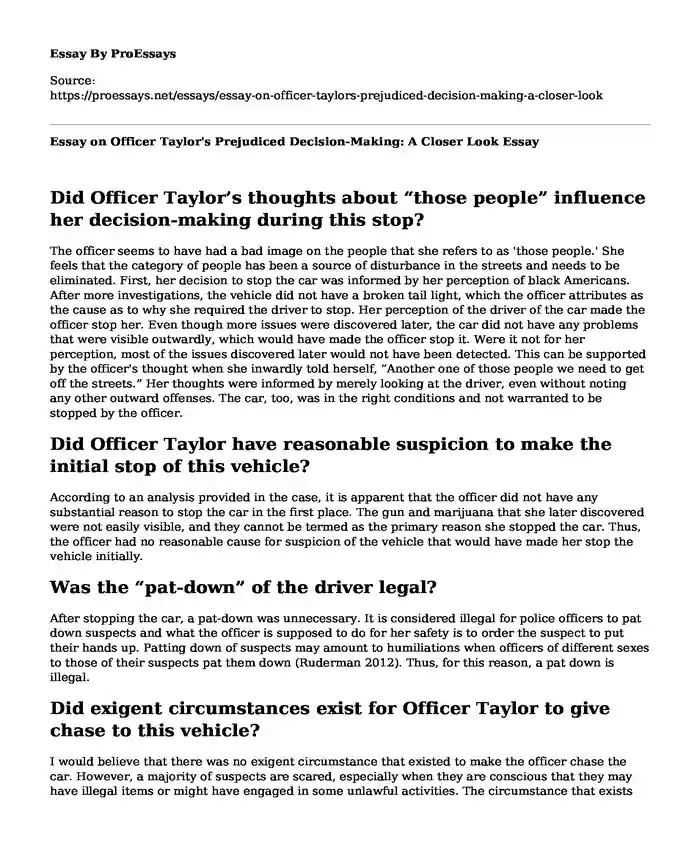Did Officer Taylor’s thoughts about “those people” influence her decision-making during this stop?
The officer seems to have had a bad image on the people that she refers to as 'those people.' She feels that the category of people has been a source of disturbance in the streets and needs to be eliminated. First, her decision to stop the car was informed by her perception of black Americans. After more investigations, the vehicle did not have a broken tail light, which the officer attributes as the cause as to why she required the driver to stop. Her perception of the driver of the car made the officer stop her. Even though more issues were discovered later, the car did not have any problems that were visible outwardly, which would have made the officer stop it. Were it not for her perception, most of the issues discovered later would not have been detected. This can be supported by the officer's thought when she inwardly told herself, “Another one of those people we need to get off the streets.” Her thoughts were informed by merely looking at the driver, even without noting any other outward offenses. The car, too, was in the right conditions and not warranted to be stopped by the officer.
Did Officer Taylor have reasonable suspicion to make the initial stop of this vehicle?
According to an analysis provided in the case, it is apparent that the officer did not have any substantial reason to stop the car in the first place. The gun and marijuana that she later discovered were not easily visible, and they cannot be termed as the primary reason she stopped the car. Thus, the officer had no reasonable cause for suspicion of the vehicle that would have made her stop the vehicle initially.
Was the “pat-down” of the driver legal?
After stopping the car, a pat-down was unnecessary. It is considered illegal for police officers to pat down suspects and what the officer is supposed to do for her safety is to order the suspect to put their hands up. Patting down of suspects may amount to humiliations when officers of different sexes to those of their suspects pat them down (Ruderman 2012). Thus, for this reason, a pat down is illegal.
Did exigent circumstances exist for Officer Taylor to give chase to this vehicle?
I would believe that there was no exigent circumstance that existed to make the officer chase the car. However, a majority of suspects are scared, especially when they are conscious that they may have illegal items or might have engaged in some unlawful activities. The circumstance that exists for Officer Taylor to give a chase to the vehicle was the fact that the driver opted to flee with the car, an issue that might have made the officer more suspicious of the driver and the car. It was later determined that there were a gun and a baggie of marijuana.
Was the gun in “plain view” and legally obtained?
The weapon was hidden beneath some documents and was only discovered by the officer when she searched identity documents in the car. Therefore, this could be an indication that the gun was not legally obtained. The plain view doctrine exempts the officers from obtaining exhibits and other items discovered in plain view during observation (O'Leary 2013). The weapon was not in plain sight hence illegally acquired.
Will marijuana baggie be admissible evidence?
The doctrine of plain view applied in the US exempts the officers from obtaining exhibits and other items discovered in plain sight during a legal observation (O'Leary 2013). Marijuana baggie was not in plain view as it was hidden in the driver's purse, which was then kept in the glove compartment. Plain sight as per the plain view doctrine is publicly apparent evidence (O'Leary 2013). Thus, the marijuana baggie was not in plain view hence exempted in the plain view doctrine. For this reason, marijuana baggie can be admissible as evidence in the court of law.
References
O'Leary, K. R. (2013). What the founders did not see coming: the fourth amendment, digital evidence, and the plain view doctrine. Suffolk UL Rev., 46, 211.Ruderman, W. (2012). For women in street stops, deeper humiliation. New York Times, 6.
Cite this page
Essay on Officer Taylor's Prejudiced Decision-Making: A Closer Look. (2023, Nov 06). Retrieved from https://proessays.net/essays/essay-on-officer-taylors-prejudiced-decision-making-a-closer-look
If you are the original author of this essay and no longer wish to have it published on the ProEssays website, please click below to request its removal:
- Appropriation of a VR Headset Gadget and the Real Estate Industry in Singapore Paper Example
- Paper Example on Social Issues Facing America Today
- Mass Incarceration in the Land of Freedom Paper Example
- The Business to Be in Future: Branding Strategies Essay Example
- Anomie Theory: From Durkheim to Merton - Essay Sample
- Essay Sample on Labelling Theory: Racism & Criminal Justice System
- Public Venture Corporation - Research Paper Example







